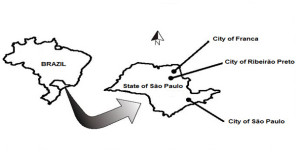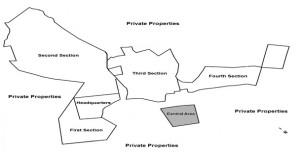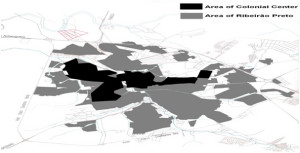3. Poor immigrants and small industrial businesses in the cities of Ribeirão Preto and Franca (1890-1960)
In the state of São Paulo, two cities – Ribeirão Preto (336 km from the city of São Paulo) and Franca (90 km from Ribeirão Preto) – gained expression with the coffee expansion across the west of the state of São Paulo.[25] In addition, Ribeirão Preto became a major central hub of coffee producers in this product’s golden age. The economy of Franca was also very influenced by this product. However, cattle raising always remained important in this town and gave rise to another segment that would subsequently be the main economic differencing activity in the city, the leather-footwear industry.
Map 1 – Location of the cities Ribeirão Preto and Franca
Source: Adapted from the Geographic and Cartographical Institute (2002).
3.1. From workers in Italy to bosses in Ribeirão Preto (1890-1930)
In 1902, approximately 63% of the population of Ribeirão Preto was foreign.[26] Out of a total of 52,929 inhabitants, 27,765 were Italians from the Veneto region.[27] This concentration of immigrants is easily explained by the importance of this city for the coffee economy. This was so much the case that in 1887, the government of the state of São Paulo created the Antonio Prado Colonial Center in this location to attract labor to be closer to the coffee plantations. Prospective owners of the lots in the Center did not necessarily need to have money, but they had to present conditions to make the land productive – by means of urban production (industry) or rural production (fresh produce) – because the trade of this production would produce the resources that the settlers needed in order to pay for their property. As noted in Map 2, unlike other colonial centers installed far away from urban centers, in Ribeirão Preto, the core was near the city’s commercial center. Because of this, this site began a process of industrialization, the main feature of which was the number of small industrial businesses established by immigrants.
Map 2 – Location of the Colonial Center in relation to the center of the city of Ribeirão Preto (1887)
Source: Data obtained from the originals of Adriana Capretz Borges Silva, Expansão urbana e formação dos territórios de pobreza em Ribeirão Preto: os bairros surgidos a partir do Núcleo Colonial Antonio Prado, master´s thesis, São Carlos, Ufscar, 2008, chapter 02.
Map 3 – Area of the Antonio Prado Colonial Center in the current urban area of Ribeirão Preto
Source: Data obtained from the originals of Adriana Adriana Capretz Borges Silva, Expansão urbana e formação dos territórios de pobreza em Ribeirão Preto: os bairros surgidos a partir do Núcleo Colonial Antonio Prado, master´s thesis, São Carlos, Ufscar, 2008, chapter 02.
The Antonio Prado Colonial Center was emancipated from the government of the State of São Paulo in 1893. In this year, most of the settlers finished paying the installments for their lots. Thus, the area of that center was incorporated into the city, along with the economic activities developed there. Map 3 above shows that such incorporation was of great importance to the city, because it expanded out from the old center. After this process was over, immigrants continued to have access to land, because lots were divided into smaller parcels and speculation ensued over them in the real estate market. The access to land through financing available in the banking and real estate networks in the city and the possibility of setting up a small business continued to shape the existence of small industrial businesses in Ribeirão Preto until 1930.
Because they were the result of modest investments, these establishments focused on craftsmanship. The small-scale industrialist had few helpers, the essential machinery to improve the work of his hands – that which was essential to the production the industrialist brought within himself, in other words, the know-how. To exemplify such a venture, we take the description below of the wagon factory of the Golfetto family. This description was listed in the records found in a post-mortem inventory of one of the family members. As we see, the establishment was modest. However, it was enough to ensure not only the family’s survival, but the acquisition of other properties in the city:
A plot of land at the Antonio Prado Colonial Center; a land below the Ribeirão Preto Farm, in the place called Tanquinho … “where there is a workshop of blacksmithing and carpentry and a small dwelling-house.”… “A great building for a workshop built of bricks covered with tiles with three rooms and a large door and a window”; a dwelling-house; a dwelling-house; “another house built of bricks, covered with tiles (in the back of above) with three rooms with a door and two windows; a mill.
FURNITURE AND TOOLS IN THE WORKSHOP:
|
PROPERTY |
VALUES |
| First: a carpenter’s bench … |
20,000 réis |
| Second, one abovementioned for a carpenter with a press… |
25,000 réis |
| Third, one abovementioned with a lathe … |
100,000 réis |
| Fourth: one abovementioned with a lathe to drill iron … |
300,000 réis |
| Fifth: one abovementioned with a lathe to smoothen iron … |
80,000 réis |
| Sixth: a large foller … |
20,000 réis |
| Seventh: an anvil … |
15,000 réis |
| Eighth: six tongs, two mallets and two hammers … |
20,000 réis |
| Ninth: seven knobs, two spanners, one being adjustable … |
10,000 réis |
| Tenth: [illegible handwriting] … |
10,000 réis |
| Eleventh: a Portuguese saw and a dinner table… |
18,000 réis |
| Twelfth: four wagon wheels, made of wood, with no iron … |
70,000 réis |
| Thirteenth: two other wagon wheels without rims, and two frames for wheelbarrows… |
50,000 réis |
Source: Post-Mortem Process Inventory of Maria Pissanelli, executor Orestes Guilherme Golfetto, replaced by his father Marco Golfetto, 1903. Public and Historic Archives of Ribeirão Preto – APHRP. Written originally in Brazilian Portuguese.
From these parameters, we seek to demonstrate the Italian and humble origins of the industrial business community of Ribeirão Preto. For this, we used empirical research based on tax documents. This consists of the License Permits in Ribeirão Preto (1891-1902), the Books of Records of Taxes on Industry, Trade, and Occupations of Ribeirão Preto (1899-1930), the Yearbook of Trade of the State of São Paulo (1904), and the Industrial Statistics of the State of São Paulo (1928, 1929, 1930) in the Public and Historic Archives of Ribeirão Preto. These sources did not mention the nationality of the persons to which they referred. Therefore, we adopted the analysis of the surnames as a criterion, relying on the distinctiveness of Italian surnames.
Access to the records of most industrial, commercial, and professional activities in Ribeirão Preto between 1890 and 1930 provided the selection of all industries, by fiscal year or the year a charter was granted. From this first selection, we highlighted all owners with Italian surnames; thus, we compared the number of owners of Italian origin versus Brazilian owners or those of other nationalities.
There were certain time periods for which the documentation was not complete. Additionally, for the year 1899, there are two books with similar content – records of businesses. However, we believe that one of them is an on-site inspection of establishments. Therefore, Table 1 shows, in addition to the data collected, the type of documentation and whether it was complete.



